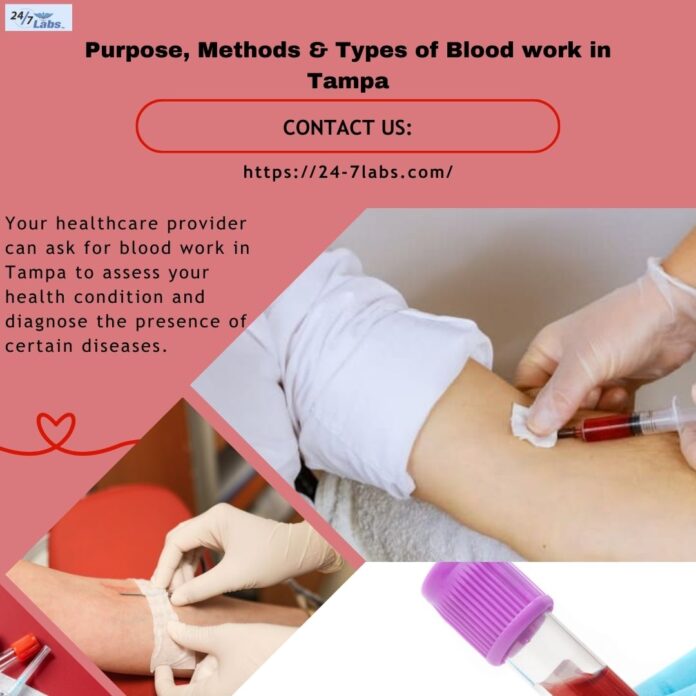Cells, chemicals, proteins, and other materials in your blood can be measured or examined with blood work in Tampa. One of the most popular kinds of laboratory tests is blood work, sometimes referred to as blood testing. Regular checkups frequently include blood work.
Purpose of Performing Blood Work
A lab analysis of substances that might be present in your blood is called a blood test. To monitor how effectively you are managing a problem, such diabetes or high cholesterol, you could have blood testing. Additionally, you could have them for regular examinations or when you are sick.
Certain diseases and ailments can be diagnosed with the aid of blood tests. It keeps track of a chronic (long-lasting) illness or condition, like high cholesterol or diabetes. Physicians can determine whether a disease’s treatment is effective. Assessing the function of your organs is also crucial. The liver, kidneys, heart, and thyroid are among your organs. Blood tests can help determine whether your immune system is struggling to combat infections and diagnose bleeding or clotting abnormalities.
Different Types of Blood Work
For blood work in Tampa, there are numerous varieties. Typical ones consist of:
Blood Clotting Tests
Another name for these tests is a coagulation panel. These tests can determine whether you have a condition that leads to excessive bleeding or clotting.
Blood Enzyme Tests
A protein called an enzyme quickens specific chemical reactions in your body. Blood enzyme testing come in a variety of forms. Troponin and creatine kinase tests are among the most popular kinds. These tests determine whether your heart muscle is injured or whether you have experienced a heart attack.
BMP (Basic Metabolic Panel)
The components in your blood, such as glucose, calcium, and electrolytes, are measured by this set of tests.
Blood Tests to check for Heart Disease
These consist of triglyceride and cholesterol tests.
CBC (Complete Blood Count)
Hemoglobin, platelets, and red and white blood cells are among the components of your blood that are measured by this test. A routine checkup frequently includes a CBC.
Methods of Blood Work
A medical professional take the sample of your blood. Another name for this is a blood draw.
Arterial Blood Test
This test is for measuring oxygen levels in your blood. Compared to blood from a vein, blood from arteries contains more oxygen. Therefore, rather of drawing blood from a vein, this test draws blood from an artery. The doctor can draw blood from groin, arm, or wrist. Usually, a provider with specialized training draws it. When the healthcare provider inserts the needle into your artery to draw blood, you can experience a searing pain.
Finger Prick Test
This test involves taking tiny amount of blood from your fingertip. Rapid tests and at-home test kits frequently involve finger prick testing. Rapid tests require little to no specialized equipment, are simple to use, and yield findings quickly.
Heel Stick Test
This test is usually for the newborns. A healthcare professional will wipe your baby’s heel with alcohol and then use a tiny needle to jab the heel during a heel stick test. The healthcare professional will apply a bandage to the area and draw a few drops of blood.
Venipuncture
Venipuncture is the process of drawing blood from a vein. Using a tiny needle, a lab specialist called a phlebotomist will draw blood from a vein in your arm during venipuncture. A tiny amount of blood will be collected into a test tube or vial following the insertion of the needle. When the doctor inserts or removes the needle, you can experience a slight sting. Usually, this takes no more than five minutes. The most popular method for doing a blood test is venipuncture.
Preparation & Risks Associated with Blood Work
For the majority of blood tests, you require no extra preparation. For certain tests, you might have to fast for a few hours prior to the test—that is, refrain from eating or drinking anything. Tell your doctor about all of your medications since you might need to stop taking some of them before your test. However, unless instructed to do so by your healthcare provider, do not discontinue taking any medications. If you need to follow any particular instructions, your provider will inform you.
A laboratory will get your blood sample. After then, skilled technicians search for the data that the healthcare provider requested. This could take a day, a week, or longer. Find out from the office of your healthcare practitioner how you might anticipate receiving the results.
A venipuncture or finger prick test carries relatively little risk. The majority of venipuncture symptoms are transient, however you can experience mild pain or bruises where the needle was inserted. A heel stick test poses very little risk to your unborn child. When the doctor pricks the heel, your baby can feel a slight pinch, and a tiny bruise might appear where it was. Although complications are uncommon, drawing blood from an artery is more painful than drawing from a vein. The area where the doctor inserts the needle may be uncomfortable, bruising, or bleeding. Additionally, for 24 hours following the exam, you should refrain from carrying heavy objects.
Conclusion
Blood work in Tampa might provide vital details about your health. However, it does not always provide adequate details about your health. Before your doctor can diagnose you, you could also require more testing if you have had blood work done. Your doctor may take into account your symptoms, medical history, and the findings of other tests in order to interpret the results of your blood test.
Your healthcare provider can learn a lot from blood testing. They can determine whether specific blood components are within a typical range. However, blood tests frequently only reveal a portion of the data required by your healthcare professional to diagnose a disease. It may be necessary for you to undergo additional tests.
Read Also: أهمية صيانة المكيفات في الظهران
